Care for the rare and challenging blue-spotted monitor (Varanus macraei).
The blue-spotted monitor (Varanus macraei) is an elongated lizard with a prehensile tail that makes up about two-thirds of its total length. Blue-spotted monitor limbs are long, slender and widely separated, ending in five thin, long-toed digits. Because of the blue-spotted monitor body’s dimensions, the neck appears quite long in this species, but it is actually no longer than the length of the skull. The nuchal scales, found at the neck, are smooth, and the caudal scales are keeled and arranged in distinct rings. The body is slightly flattened dorsolaterally, and it is predominantly black, or very dark gray, and is marked with turquoise-blue ocelli (eye-like spots). There are blue-gray bands around the length of the tail of the blue-spotted monitor. The belly is grayish to pale powder blue, with some dark-gray mottling. The tongue is pale pink.
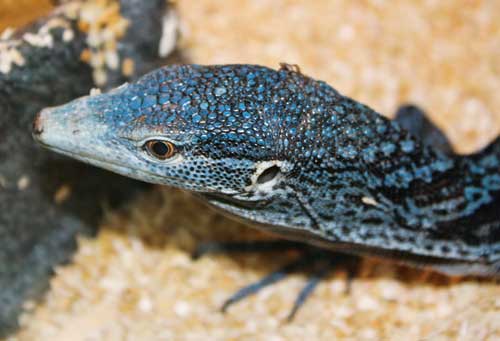
The blue-spotted monitor has smooth nuchal scales.
Male blue-spotted monitors reach a larger maximum size than female blue-spotted monitors, and they can be distinguished by the comparatively broader temporal region and distinct hemipenal bulges posterolateral to the cloaca. Adult male blue-spotted monitors may reach 3½ feet in total length, and female blue-spotted monitors are about 4 inches shorter than the male blue-spotted monitors, making V. macraei the largest known species of the V. prasinus complex, a group of very similar, related species that are closer to each other than even other members in the same genus. The blue-spotted monitor also has what may be the smallest distribution of the tree monitors, restricted to Batanta Island, northwest of the Vogelkop Peninsula of Irian Jaya, Indonesian New Guinea.
Also called the blue tree monitor, Varanus macraei is a diurnal species that seems to be almost completely arboreal. Their sharp claws give them a secure hold on almost any rough surface, and they can climb with considerable ease. While moving amongst branches, they employ their prehensile tail as a grasping tool, in much the same way that chameleons use their tails. Unlike chameleons, though, monitors may coil their tails on a plane horizontal to their bodies and rapidly uncoil the appendage for use as a defensive whip. This nervous species avoids potential predators by fleeing up trees and keeping the tree trunk between itself and the intruder, much as squirrels do.
Blue-spotted monitor natural habitat consists of tropical forests where daytime temperatures fluctuate between 83 and 100 degrees Fahrenheit, and may drop 2 to 4 degrees in the evening. Humidity ranges from a dry-season low of near 65 percent up to 100 percent in the wet season. Blue-spotted monitor natural diet is unknown. However, if consistent with that of the other tree monitor species, it is primarily made up of (in order) stick insects, orthopterans (grasshoppers, katydids and crickets), moths, beetles, smaller lizards, small eggs and the occasional berry.
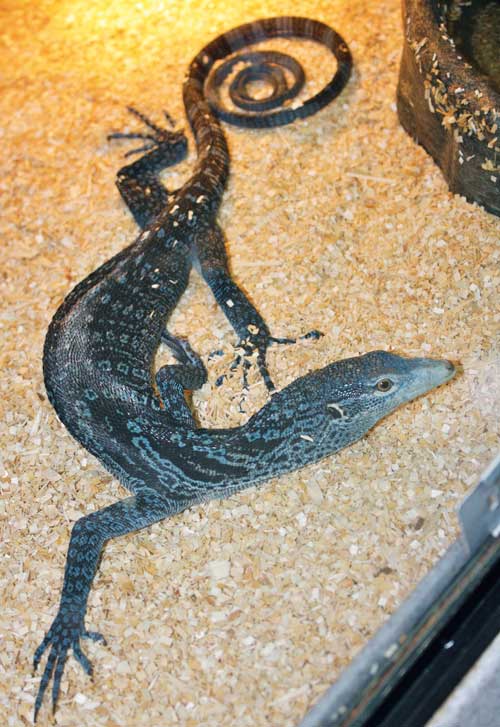
Varanus macraei’s long tail is used like a whip when the animal must defend itself.
Tree Monitor Breakdown
As recently as a decade ago, only five species comprised the tree monitor group: Varanus prasinus, V. beccarii, V. bogerti, V. keithhornei and V. telenesetes. In the early years of the 21st century, that number has been supplemented with the discoveries and naming of V. macraei, V. boehmei, and V. reisingeri. The considerable similarity among these species made them difficult to differentiate. Some individuals of the decidedly green V. prasinus have very little yellow pigmentation, and thus appear pale blue. Varanus reisingeri can very well be described as looking like V. prasinus without blue pigmentation. While there are very few reports — and no specific field studies — relating to the natural history of any of the tree monitors, there is a considerable body of knowledge available for the green tree monitor (V. prasinus) and the black tree monitor (V. beccarii), two of the species that have been very successfully maintained and bred in captivity for more than two decades. Consequently, several herpetoculturists and at least two zoos have now kept and bred the blue-spotted monitor (V. macraei).
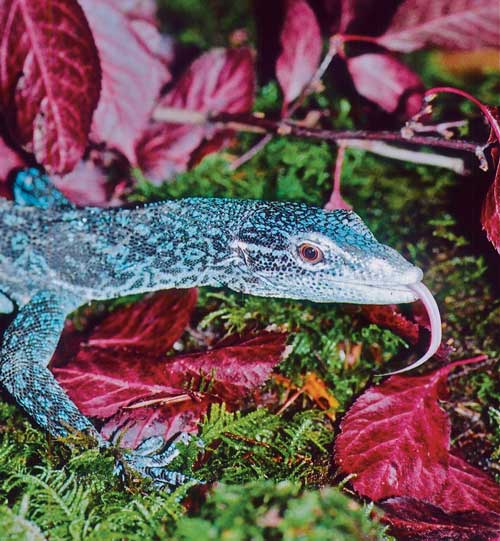
In nature, Varanus macraei lives in tropical forests where daytime temperatures are between 83 and 100 degrees Fahrenheit.
Delicate and Specific Needs
If you are fortunate enough to acquire a breeding group of blue-spotted monitors, be prepared to give them the proper care that such a delicate species requires. Like the black tree monitor, blue-spotted monitors are extremely wary lizards, and newly acquired blue-spotted monitors may be hyperactive and prone to run into walls at the least disturbance. There are several options for protecting blue-spotted monitors from damaging itself.
First, be sure to provide an adequately large terrarium. Of course it should be as large as you can provide, but should have minimum dimensions of about 6 feet to each side and 3 feet tall.
Second, use some sort of screen to limit the blue-spotted monitors’ vision outside the terrarium; construct a window of one-way glass, or cover all or part of the windows with tinted plastic or smoky-black Plexiglas. These options are better than simply covering the windows with cardboard or towels, because they still allow the keeper to see into the terrarium.
Third, provide several hiding spots that are large enough for the blue-spotted monitors to feel secure. If you use a tree trunk, be sure it is both tall and wide enough to allow the blue-spotted monitors to hide completely and turn around easily once inside. Several hide boxes are useful both for making blue-spotted monitors feel secure and for use as possible nest sites during breeding.
The terrarium should have at least one broad, tall tree trunk (or similar central climbing post) and several horizontal branches or boards. Given that blue-spotted monitors are arboreal, they will be most comfortable in an enclosure that simulates the complex and abundant branching found in treetops.
For substrate, use a clean soil or soil and sand mixture about a foot in depth. Clean bark chips also suffice, but if breeding is desired, there must be a large box of soil 12 inches deep.
A large container of water should be available to the blue-spotted monitors at all times. Tree monitors will drink from standing water and frequently soak in a pool (especially prior to shedding). Standing water also helps maintain the high-humidity level these lizards require. If you want to simulate the natural environment more closely, provide intense spraying of water in the afternoon for about three months; no spraying for three months; and one to two sprayings weekly during the periods between the wet and dry seasons.
Ventilation is a must to keep air from becoming stagnant and to prevent the growth of mold and fungi. The top of the terrarium should be solid, save for apertures for lighting. Place ventilation holes near the upper portion of a side wall on one side of the terrarium, and near the floor on the other. This ventilation will allow air to cycle through the enclosure naturally but not so fast as to cause drafts or lower temperatures.
Light the Way
All tree monitors seem to be very susceptible to illness if temperatures fall below a certain threshold. The ambient air temperature of the terrarium should be kept between 83 to 100 degrees. An isolated basking spot located near the top of the terrarium should be allowed to reach 104 to 108 degrees. Aside from the basking site, which should be directly lit by a heat lamp, the rest of the lighting should be indirect; that is, provide enough cover (simulating leaves and branches) so that the terrarium is heated, but there are few places where direct lighting falls all the way to the floor. The photoperiod should vary from 10 to 13 hours of light per day.
Fit the terrarium with a good full-spectrum light to provide the levels of ultraviolet exposure needed to facilitate proper physiological use of vitamin D3 and calcium.
Handle With Care
Another point to remember is that blue-spotted monitors have very sharp claws. Even specimens that have calmed enough to allow gentle handling can easily cause scratches that break human skin. For this reason, always wear gloves and long sleeves when handling tree monitors.
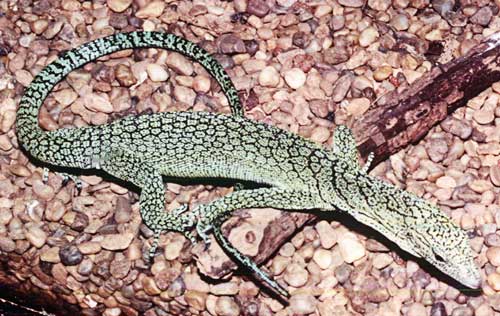
Although easy to distinguish in this picture, the green tree monitor (Varanus prasinus) does have a blue phase that can make it look similar to V. macraei.
Feed Wisely
It is unlikely that herpetoculturists will be able to offer blue-spotted monitors anything near the dietary variety that they consume in the species-rich rain forest. Crickets are an excellent food item, and one that is part of the natural diet. Roaches, grasshoppers and other large insects are also excellent choices, if available. Be sure that all insects used as food have been fed fresh, green vegetable matter (such as lettuce, spinach and celery leaves) a day or more before feeding them to the lizards. Dust insect foods and the insects with a calcium/phosphorus supplement. Because these are such active lizards, they should have live foods available daily; what they do not consume one day, they should catch and eat the next. Successful keepers have also given blue-spotted monitors freshly killed young mice. Though these are not part of a natural diet, mice do provide a full repertoire of vitamins and minerals, especially calcium, to the blue-spotted monitors.
Breeding the Rare Blue-Spotted Monitor
Getting blue-spotted monitors (Varanus macraei) to reproduce is still a rare accomplishment, but it has been done by several herpetoculturists. Ideally, female blue-spotted monitors will be separated from males until mating is intended, at which time you may introduce the female into the male’s terrarium. If the female is receptive to mating, she will usually approach the male blue-spotted monitor. The two may spend time basking on the same perch over a period of days, or they may initiate mating immediately. During gestation, female blue-spotted monitors become more active, requiring more food. They should have insects daily in addition to whatever else they are being fed. They also spend a considerable amount of time under the basking lamp, thus elevating their body temperature quite a bit.
As is typical of the slender-bodied tree monitor clan, blue-spotted monitor females will not — or just barely — appear gravid right up to the time of egg laying.
Equip the terrarium with hide boxes that can be used for egg deposition. The boxes should be firmly attached to the terrarium wall, easily accessed by the blue-spotted monitors from inside the terrarium, and have a second door that allows you access to the box’s contents from outside the enclosure. The inside of the nestbox should have a layer of leaf litter, potting soil, vermiculite, loamy sand or sphagnum moss, all materials that will retain some moisture. The medium should be very slightly moist, not wet. Some three to five weeks after mating, the female blue-spotted monitors will seek out the nestboxes and deposit three to six eggs.
Carefully remove and incubate the blue-spotted monitor eggs 84 to 86 degrees Fahrenheit on a medium such as that used in the nestbox. Hatching takes place after 150 days.
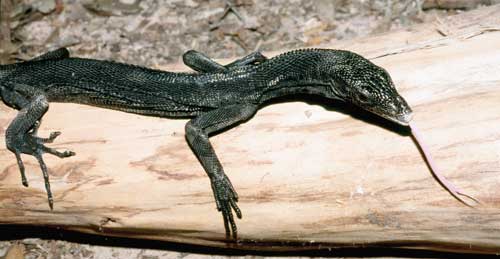
Like the blue-spotted monitor (Varanus macraei), the black tree monitor (V. beccarii) is very wary and easily startled.
Special Considerations
At present, there are very few blue-spotted monitors being captive bred. Consequently, animals that make it to the trade are wild caught, and thus may have diseases, parasites or both. Newly acquired specimens should be kept quarantined and given a thorough examination for any signs of ill health. Given that a pair of blue-spotted monitors could cost $2,000 or more (some of us still consider even $1,000 a lot of money), it would be a wise investment to take new animals for a professional veterinary checkup.
References
Eidenmüller, B. 2003. Warane lebensweise, pflege, zucht. Herpeton, 2003: 86.
Dedlmar, A. 2007. “Haltung, Pflege und Nachtzucht von Varanus macraei.” Reptilia, 63 12(1): 39-41.
Jacobs, H.J. 2002. “Erstnachzucht von Varanus macraei.” Herpetofauna 24(141): 29-33.
Mendyk, R. 2007. Dizygotic twinning in the blue tree monitor, Varanus macraei. Biawak. 1(1): 26-28.
Moldovan, D. 2008. Haltung und Zucht von Varanus (Euprepiosaurus) macraei Bohme & Jacobs, 2001. Sauria 30(4): 5-10.
Ziegler, T, M. Strauch, T. Pes, J. Konas, T. Jirasek, N. Rütz, J. Oberreuter, and S. Holst. 2009.
First Captive Breeding of the Blue-Spotted Tree Monitor Varanus macraei Bohme & Jacobs, 2001 at the Plzen and Cologne Zoos. Biawak 3(4): 122-133.


